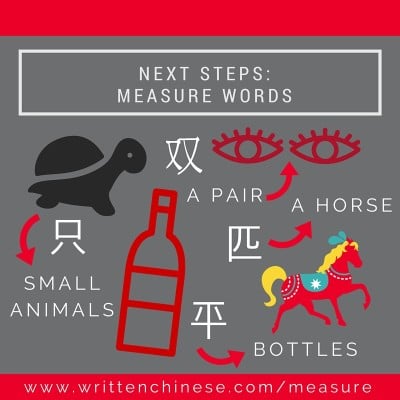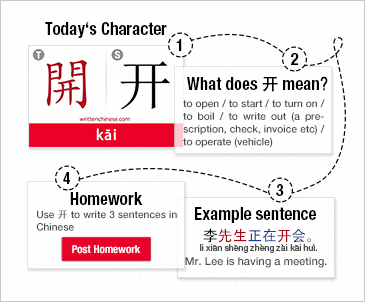How to Learn Chinese
Welcome 欢迎!

You’ve arrived! Welcome to the Written Chinese ‘How to Learn Chinese’ page – We’re really glad you’ve joined us! Now we’d like to prepare you for your learning experience by introducing some essential tools and preparation before you begin your studies. Once you’ve checked off the following list below we can begin our Chinese learning adventure together!
Chinese Learning Checklist

Step 1. Get yourself a dictionary (book, online and mobile app)
Having a reliable dictionary is essential when learning a new language, especially when you’re studying on your own. Whilst actual physical dictionaries are great at home or at school, an online dictionary or mobile app is more convenient for when you’re on the go. Although what a language learner wants in a dictionary is personal, we believe that a truly useful dictionary should feature more than just a translation.
Consider what your goals are for learning Chinese. If you want to learn to write Chinese characters, then you’ll need to know how to write the character. For this, stroke animation is essential. What about pronunciation? When you’re starting out, learning the tones and pronunciation of Chinese words is really important, so you’ll probably need to listen to the way they are spoken. You may have heard about radicals: these are the ‘building blocks’ of Chinese characters. Learning to read Chinese without these would be very difficult, if not impossible!
Step 2. Learn some Chinese keywords and phrases
Once you begin learning Chinese, you might come across some words that you’re not familiar with. We’ve created a glossary of words that are important for student of Chinese to know such as radicals, pinyin or important facts such as the difference between Mandarin Chinese and Cantonese.
Step 3. Install pinyin and handwriting keyboards for your electronic devices.
Without these keyboards you will struggle to search in a dictionary app, online dictionary or use your written Chinese to communicate with friends or even use a Chinese website.
There are two main kind of keyboards (there are other methods but they’re a little more complicated. You can read about one named the Wubi Method here.)
#1. Pinyin Keyboard. This keyboard allows you to type using pinyin from which you choose the correct Chinese character. Learn how to add a Pinyin keyboard to your device.
#2. Handwriting Keyboard. The handwriting keyboard allows you to use your finger as a pen and write the character using strokes on your mobile device touchscreen. Learn how to add a handwriting keyboard to your device.
Step 4. Find some reputable resources, books, mp3s or course to follow.

It’s very difficult to start learning Chinese without some kind of direction. Whilst some people aim to take an HSK exam (get more information about the HSK exams here, others plan to complete a textbook or course.
Below are some resource suggestions, including textbooks and courses that the non-Chinese natives of the Written Chinese Team have used ourselves.
Step 5. Make time to Study!

Everyone studies in their own way, with their own methods, with different resources and with different expectations. No matter how you learn, you still need to take the time out of your day to study in order to see improvements and to stay interested in learning.
We suggest creating a routine for learning, so that you reach your goals and feel enthusiastic about learning Chinese!
Fellow colleague, Mike, is big on routines and making time to study (even though he’s a crazy busy guy). You can read more about Mike’s learning routine here.
Of course, your learning goals may change and so can your schedule! You don’t need to spend hours studying every day, even just finding 10 minutes to study could make all the difference!
Here are some ideas for organizing your study time and staying challenged!
- Plan to study 2 pages a day from your textbook.
- Learn a small amount of characters, or new vocabulary every day (and make a chart to record them).
- Keep a small Chinese learning notebook with you to note down vocabulary you want to learn or have learned (you could even practice writing your daily characters). Even better, if you have the WCC Dictionary, you can search for the word and add it to your ‘Quick List’. When you have some spare time, review the words or even test yourself with the ‘Study’ tool.
- Sign up for the Written Chinese Study Space on your computer and learn the Character of the Day.
- Be part of the Online Living Dictionary by posting your Homework of the Day, character mnemonics or even images or videos that help you remember a character.
- Listen to a Chinese learning podcast (that’s relevant to your Chinese level) on your commute to work or school.
Step 6. Learn Something about Chinese Culture and History

Understanding just a little about Chinese culture, will really enhance your understanding of the language, especially Chinese characters. Even if you’re studying simplified characters, its interesting and useful to know a little about character etymology, especially when it comes to learning pictographic characters.
We don’t expect anyone to become experts, even students of Chinese that have been studying for a few years regularly learn something new about Chinese culture that they didn’t know!
The first thing you can do is listen to the Two White Chicks in China. It’s hosted by myself (Hollie) and Nora and we talk about Chinese culture, and what it’s really like to live in China.
Listen to the Two White Chicks in China here!
Now you’ve got your tools you’re ready to go!
Below are the four main areas of focus with any language: spoken Chinese (speaking and listening) and written Chinese (reading and writing). Most of the time, however, these four areas do not exist independently from one another and to focus on purely one area is impossible.

To be able to speak Chinese, you need to have not only listened to pronunciation and tones, but being able to read characters will also help improve your spoken Chinese.
To be able to write, you also need to be able to read and interpret Chinese characters correctly.
Below are some way in which you can begin to learn these four areas and embrace your learning experience!
Spoken Chinese
Although we focus on learning the written Chinese language, we still have tools and resources that can also help with your spoken Chinese.
We believe that learning to read and write can actually improve your spoken Chinese because it helps make connections between words.
Below are some areas to study or focus on to help your spoken Chinese:
Tones
Learning the Chinese tones can often be a struggle and many people ask ‘Are tones really that important?’ Of course, context of a conversation helps distinguish between different words. So for example, it would probably be very difficult to get confused between 好 (hǎo) which generally means ‘good’ and 号 (hào), often used to indicate a date or number. However, the answer is still ‘yes, tones are important’. Firstly, context cannot save you all the time. Secondly, if someone was learning your native language, you would expect them to speak it properly, not spock eet praperlu…
The are plenty of ways to learn the correct tones, here are a few ideas to get you started:
If you don’t live in China:
- Listen to Chinese learning mp3s or podcasts, or even Chinese radio stations.
- Watch Chinese TV. If you’re a beginner watch children’s cartoons or short animations.
If you live in China:
- If you’re in China, you’re lucky enough to be able to listen to Chinese people all day long (or little people if you’re an English teacher)!
- Practice your tones by chatting with taxi drivers, if they understand you, you’re probably doing well. If not, take more taxis!
Regardless of where you are in the world:
- Use the Chinese Tone Trainer with a built in score. Listen to the spoken pinyin and choose the tone you hear.
- Use the coloured tones in both the online dictionary and WCC Dictionary to help you remember how to pronounce a character.
Talking with Other Chinese Speakers

There really is no better way than practicing your spoken Chinese than by talking to Chinese speakers. Lots of people who live in China take advantage of their environment by chatting with taxi drivers, colleagues and even security guards. People are often very willing to answer questions about Chinese culture or how to say something in Chinese.
But speaking practice is much more difficult if you don’t live in China. If you’re lucky enough to live in a city that has a Chinese school, this would definitely be the place to start. If you’re still struggling to find a buddy to have a chat with, there are also language tutor platforms online that can pair a language learner with a teacher of that language. You can also have classes on your own time, instead of having to follow a school timetable. After signing up, it’s usually just as simple as finding a tutor you would like to have teach you and booking a block of time. They’ll ask you what level you’re on and what you want to learn. You’re not restricted to one teacher either, you can try out a number of different tutors until you find the one that’s right for you!
Listening to Chinese

Aural and spoken language come hand in hand, so many of the tips and suggestions for Spoken Chinese, also apply for listening to it.
One of the most important things you can do when learning a language is really open yourself up to the language and just listen, instead of obsessing over understanding every single word.Some great ways to listen to Chinese is to use mp3s, listen to music, the radio or even watch TV shows. You’ll hear repeated sentence patterns, ‘day-to-day’ language and of course, learn new words. One of the biggest challenges about listening and understanding what is being spoken in Chinese, is experiencing the many dialects and pronunciations that exist in China!
- Listen to Chinese Radio
- Chinese Music Vault
- Get MP3s
- Watch Chinese TV Shows
- Listen to a podcast
Reading Chinese Characters
Radicals

Radicals will soon be the reason that you’ll laugh at ever having been afraid of learning Chinese Characters!
Before you really begin to learn to read, never mind write Chinese characters, you need to be aware of radicals. A radical is a ‘building block’ that makes up a Chinese character; they represent meaning, pronunciation and without understanding them reading characters would probably take way longer!To get to grips with radicals and learn how to utilize them in your Chinese learning listed below are articles related to radicals.
- Radicals Are Your Friend
- The Radical Truth: The Importance of Learning Radicals
I’m sure radicals make a lot more sense now, right? You can read more articles about specific radicals here.
Bigrams

As Chinese learners ourselves, we are more than aware of the many different meanings that each character can have or that on their own they can be difficult to understand. If you’re new to Chinese, learning each individual character can be a tricky task, which is why, when you search for a word in the WCC Dictionary the first results are the Top 3 Bigrams.
Instead of getting stressed out trying to remember the meaning of 以 (yǐ) and how to use it. You’d be better learning that 可 (kě) and 以 (yǐ) make the bigram 可以 (kě yǐ) meaning ‘can’.
If you’re interesting in learning how to use Bigrams to learn Chinese, you can read the article ‘Why Learning Chinese Characters is Easier in Twos’ to find out more.
Writing Chinese Characters
Strokes

Now you’re at the writing stage of your journey, it’s important to learn how to write the characters. Just like learning to write the alphabet (although you may not remember) there is also a correct order to write each stroke in a character (or radical).
Although it’s not essential to know all the stroke rules straight away, you should be aware of them as you begin to write, including the names of each stroke. This might sound pointless and an additional nuisance you didn’t expect, but it’ll be worth it in order to write correctly.
Stroke types
There are a number of strokes that you should learn in order to write Chinese correctly, although initially it is probably enough just to learn 5 or 6. You may think that the more complicated characters are impossible to remember, never mind write, but that’s the beauty of radicals; you can learn to write these characters because of these radical building blocks!
Stroke order
The order of the strokes is probably more important than learning the stroke names, as this could be the difference between legible handwriting and not. Although there are a set of rules, there are some characters that go against these rules, so it’s still important to use a stroke animation feature in the Online Dictionary.
You can find the names of the strokes, and which order to write them in this article Chinese Character Stroke Rules and How to Break Them.
I know the basics, now what?
Measure words

Chinese, like the English language, also has measure words. In English we call them partitives, countable nouns or quantifiers. In Chinese, they are known as 量词 (liàng cí) and, as in English they come in many varieties. At first, it’s normal to just use the measure word 一个 (yī gè), but once you begin listening to Chinese more and more you will begin to hear new measure words. Even if you can’t remember them all, it’s good to have an awareness of them, or you’ll get hung up on not understanding a sentence or phrase.
You can begin by labeling items in your home, or on your desk at work. Applying measure words to your Chinese will not be too difficult once you’ve mastered the basics. However, it is worth pointing out that some nouns have more than one classifier and some measure word ‘criteria’ can be flexible.
You can read our article, Weighing Up Measure Words, to learn about classifiers and when to use them.
It’s exam time!

Once you’ve started to feel comfortable with your learning, it might be time to consider applying to take an HSK exam. I know, I know, the idea of taking an exam fills you with fear and dread, but taking an HSK exam is really not that bad.
Firstly, the format is always the same. The examination board aren’t going to stick a random extra element into the exam to slip you up. If you’ve studied the prescribed vocabulary and characters, taken a few exam papers, including the listening section and been given a hint from your Chinese teacher, now is the time to take an HSK exam.
You can read the following two articles to find out more:
- So you want to take the HSK? Here are 9 Tips!
- Preparing For an HSK Exam: Advice From a Wannabe Master of Chinese
Your Questions
If you have a question about learning Chinese or a specific question about the Chinese language, just drop us an email at [email protected] or start chatting with us in the red box at the bottom of the page!





